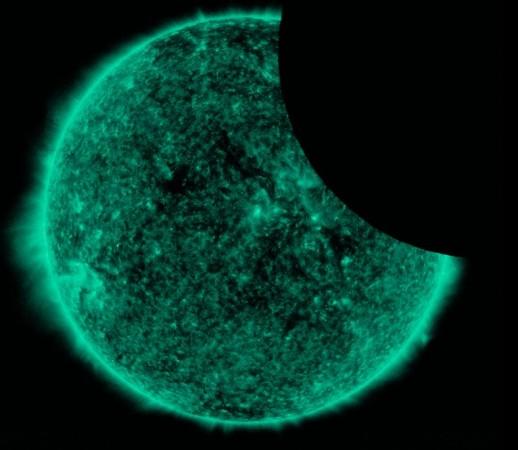It looks like not only humans but celestial bodies also like to photobomb. A video by NASA's Solar Dynamics Observatory (SDO), which has gone viral, shows the Moon photobombing the Sun.
The spacecraft captured the incredible moment on October 19 when the Moon covered about 26 percent of the Sun. According to NASA, the lunar transit lasted about 45 minutes, between 3.41 pm and 4.25 pm EDT.
The shadow of the Moon can be seen appearing from the top left side of the Sun, covering 26 percent at its peak.

"The Moon's shadow obstructs SDO's otherwise constant view of the Sun, and the shadow's edge is sharp and distinct since the Moon has no atmosphere which would distort sunlight," NASA said in a statement.
"SDO captured these images in a wavelength of extreme ultraviolet light that shows solar material heated to more than 10 million degrees Fahrenheit. This kind of light is invisible to human eyes, but colourized here in green."
NASA even shared the GIF of the incredible moment with a caption, "On Oct 19, the Moon photobombed our @NASASun observatory that typically watches the Sun 24/7. Take a look."
On Oct 19, the Moon photobombed our @NASASun observatory that typically watches the Sun 24/7. Take a look: https://t.co/AjQdhZDXMm pic.twitter.com/gvuaq7CA2b
— NASA (@NASA) October 20, 2017
NASA Moon's Twitter handle replied to the tweet and said, "Yup."
— NASA Moon (@NASAMoon) October 20, 2017
The GIF has gone viral on social media with tweeple coming up with funny reactions. Check out the Twitter reactions below.
Such a sassy moon! ?
— Fareda Mo (@FaredaMo) October 20, 2017
— Chasity (@Chasity_Shelton) October 20, 2017
LOL NASA got mooned
— ɹɐɔǝɔɐɹ (@SenseiSoTA) October 21, 2017
Instead of a crescent moon we got a crescent sun
— David Conley (@Pug_Whiskers) October 21, 2017
Silly moon trying to get some attention with a photobomb! https://t.co/z04PkRyAxr
— NWS (@NWS) October 20, 2017
What a joker! ??? https://t.co/aGLgOalVbf
— Kirsty Duncan (@KirstyDuncanMP) October 20, 2017
Narcissistic moon! Always trying to get in the pic. https://t.co/Xyhk9XD0Bk
— Stacy Kish (@StacyWKish) October 20, 2017
Wonderful! @NASA observing the Sun then the Moon makes a cameo appearance. https://t.co/B5UL3e3r0i
— martin reilly (@martinobhoy) October 20, 2017
The SDO monitors the Sun 24/7 to study its atmosphere and effects on the near-Earth environment. In September, it had captured the biggest solar flares, powerful bursts of radiation, in 12 years.
"X-class denotes the most intense flares, while the number provides more information about its strength. An X2 is twice as intense as an X1, an X3 is three times as intense, etc. The X9.3 flare was the largest flare so far in the current solar cycle, the approximately 11-year-cycle during which the sun's activity waxes and wanes," NASA explained.















